 Miki and Reiko rock and rule Osaka in 1973's Sukeban. 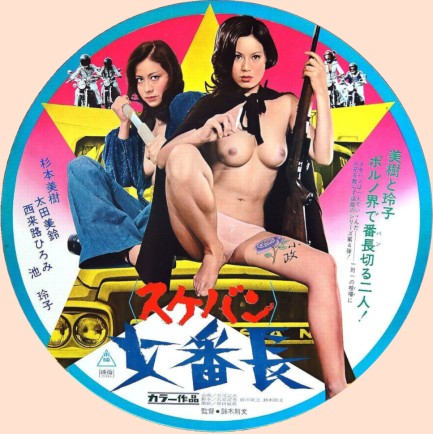
We already shared this rare circular poster for Sukeban, aka Girl Boss Revenge: Sukeban, in a group post years ago, but since it's so rare and interesting we're bringing it back for a solo look, and as you see below we've split it in half to allow you to have your own copy of reasonable size, if you're inclined to put the two pieces together. We might as well comment on the movie too. When we first shared the art for this, we figured why discuss the film in detail when there were already plenty of reviews online? We even linked to one back then. Little did we know that Pulp Intl. would still be going ten years later and would be a top repository for vintage Japanese poster art online. That being the case, we figure we'll tell you about the movie this time.
It stars two of the brightest stars of the Japanese grindhouse era—Miki Sugimoto and Reiko Ike. Miki plays a gang leader who calls herself Kantô Komasa, while Reiko is the girl gang leader of Namairu High School. They meet in a prison van and escape simultaneously, headed different directions but destined to cross paths again. Miki forms a new gang in Osaka called Gypsy Dance, gets into the usual delinquency, and meets a director of dirty movies who she enlists in a revenge plot. But all the fun and games take a nasty turn when she runs afoul of the North Dragon yakuza and they start dishing out pain and suffering. Only with the help of a young North Dragon footsoldier named Tatsuo is Miki able to escape her predicament.
It just so happens that Tatsuo is Reiko's boyfriend. Reiko has been missing since her escape from the prison van, but arrives on the scene just in time to find Miki in bed with her man. That puts Reiko and Miki at odds in the worst way, but Reiko has no idea Tatsuo is working for the North Dragon. She'll find out, though, via a stunning betrayal. We'll end the synopsis there, but add the warning that the North Dragon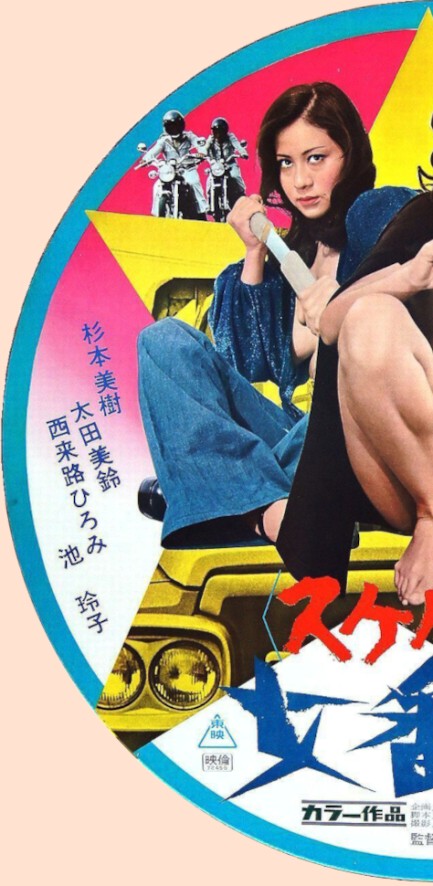 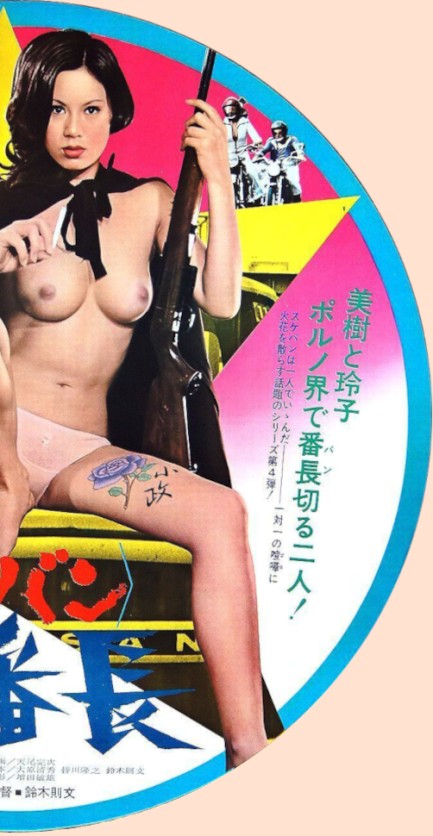 are mean as hell and the tortures they administer are hard to watch. But gangsters gonna gangster—if they spent their time at garden parties and poetry readings there'd be a different word for them. are mean as hell and the tortures they administer are hard to watch. But gangsters gonna gangster—if they spent their time at garden parties and poetry readings there'd be a different word for them.
Sukeban, which was directed by Norifumi Suzuki, is a prime example of Toei Company's pinky violence genre—wild, colorful, gritty, and bloody, with moments of humor to leaven the hard tone. Movies of this style influenced many later directors, but apart from Quentin Tarantino and maybe a couple of other mavericks such operatic exploitation is a relic of the past. The film is basically Miki's show, and whether rolling fabulously down a hill in her fur coat and platforms or getting dirty in an alley fight, she delivers a freewheeling performance in a production that isn't for the faint of heart. It's worth watching for its historical value as well as for entertainment, but in either case, hold onto your hat.
As a bonus, below we have some production photos, including a rare image of Miki striking the topless pose used to create the promo poster. We always thought her head looked a little warped on that poster. Turns out it's a defect in the original photograph—someone either shot her off-kilter or introduced the flaw during the developing process, and she stayed that way. We're guessing, but we're pretty sure because normally her head is very symmetrical. As is the rest of her. You'll see what we mean below about the photo. Sukeban premiered in Japan today in 1973. You can see our other write-up on it here.
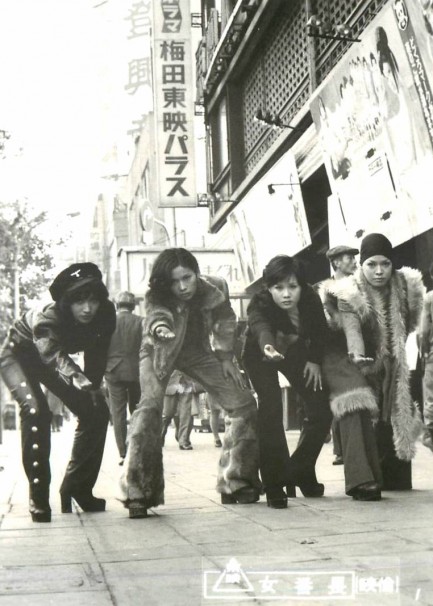 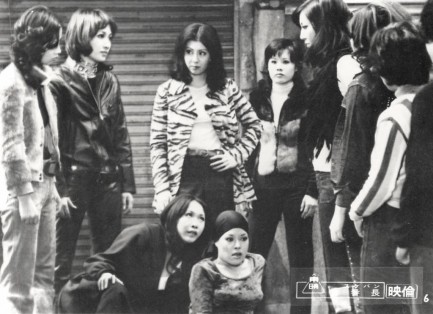 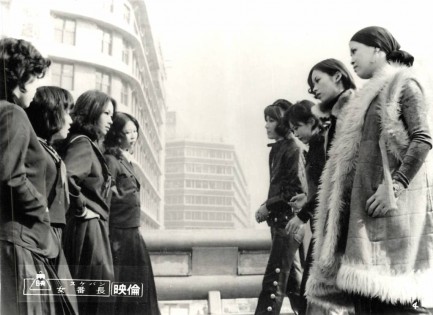 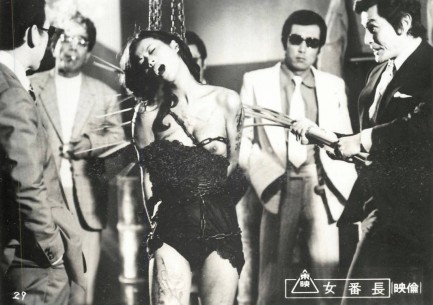 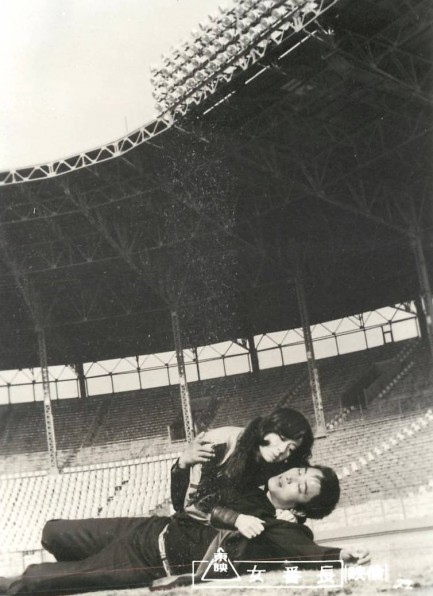 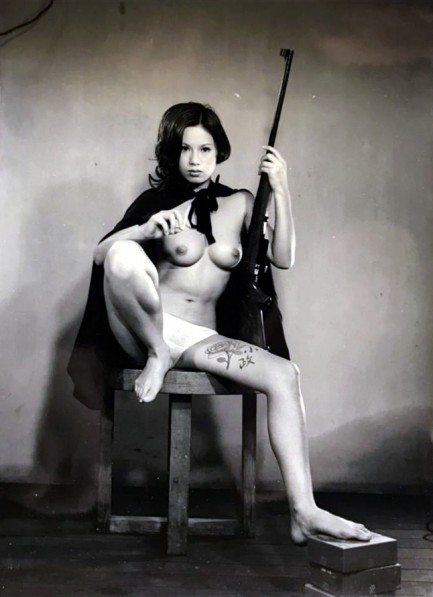
 Whether she has to use bullets, a blade or her bare hands, she’s gonna make you pay. 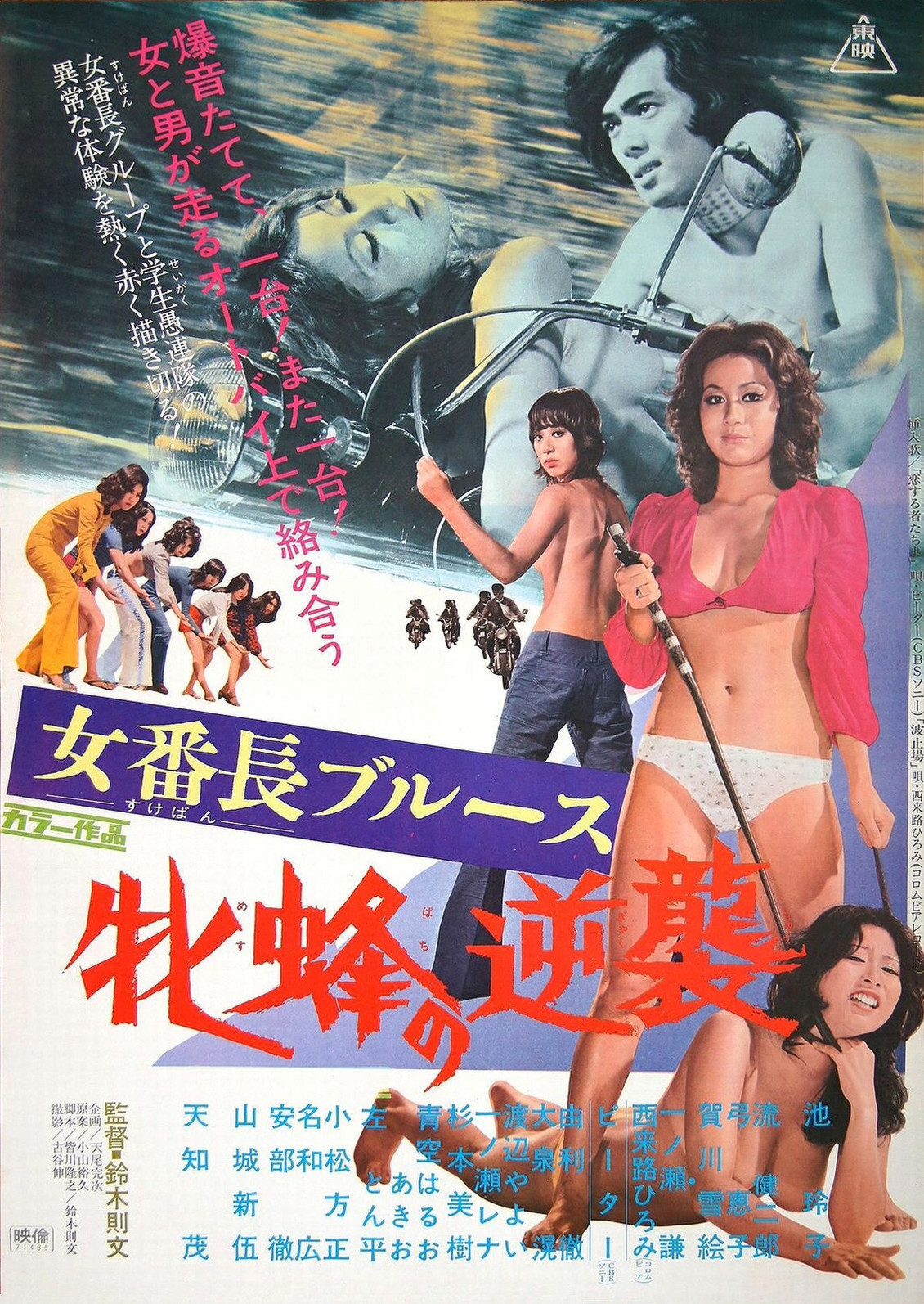 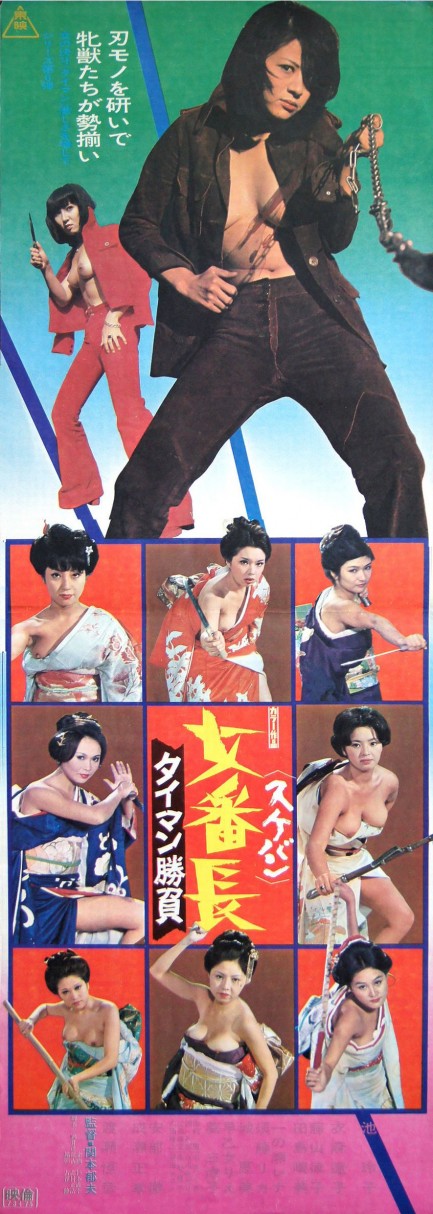 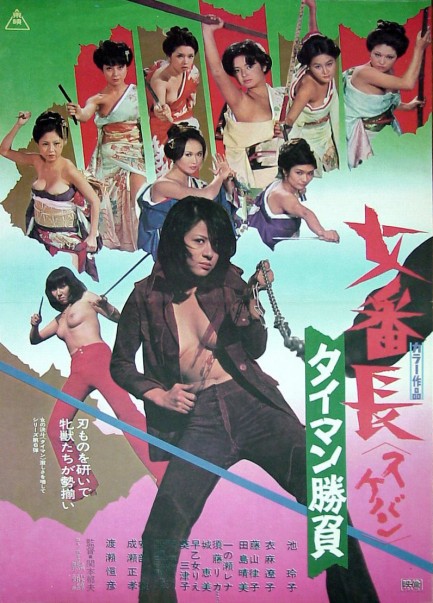 _m_(aka_violence_sweeper)_m_1974.jpg) 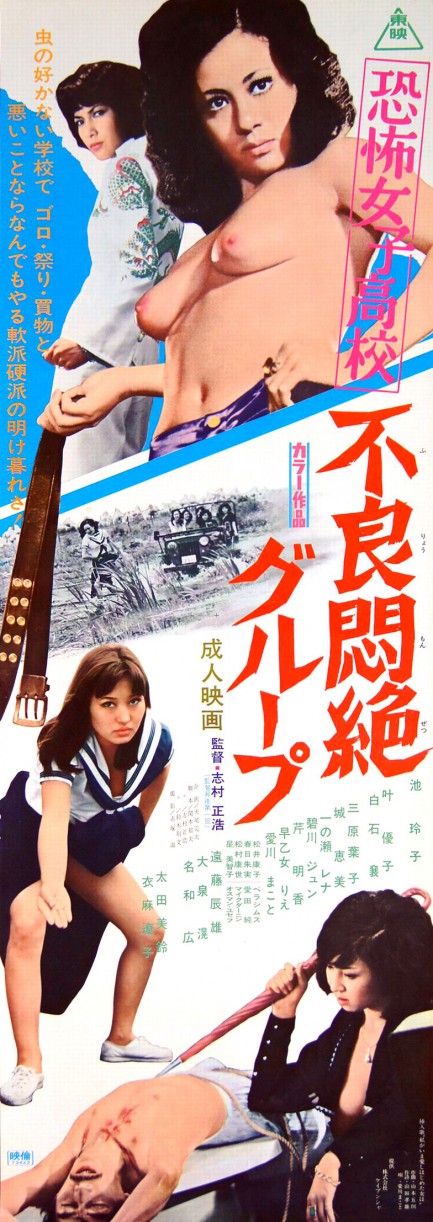 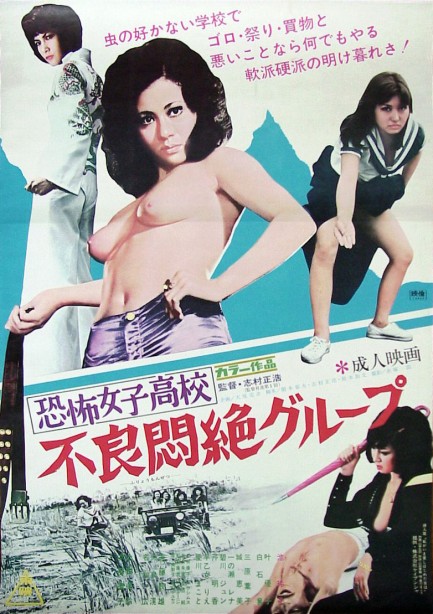 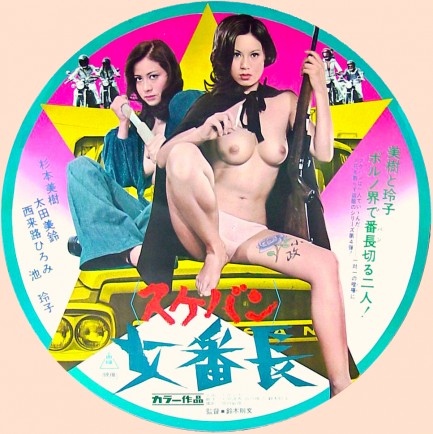 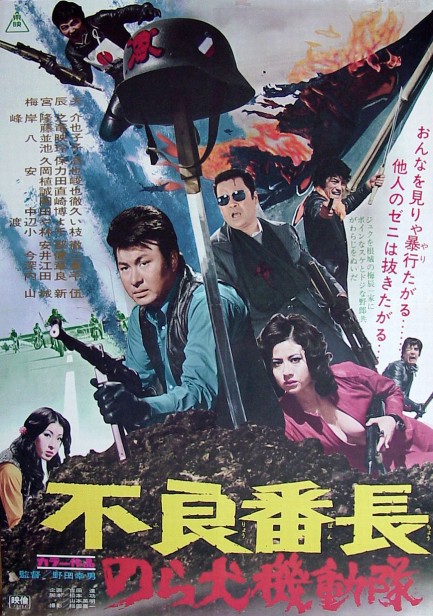
Above are nine vintage Japanese pinku posters from our large collection, for films featuring that scourge of evil men everywhere—Reiko Ike. These are circa 1971 to 1974, and they are, top to bottom, 1: Sukeban burûsu: Mesubachi no gyakushû, aka Girl Boss Blues: Queen Bee’s Counterattack; 2 & 3: Sukeban: Taiman shobu, aka, Girl Boss: Mano a Mano; 4: Kuroi mehyô M, aka Black Panther Bitch M; 5 & 6: Kyofu joshikôkô: Furyo monzetsu guruupu, aka Terrifying Girls' High School: Delinquent Convulsion Group; 7: a rare and valuable round poster for Sukeban, aka Girl Boss Revenge; Sukeban; 8: Furyo bancho: Norainu kidotai, aka Wolves of the City: Alley Dog Commando. A quick word about the last one: that is Reiko Ike on the poster, with a machine gun at lower right. We’ve seen this debated on a couple of websites, but there’s no debate—it’s her, beauty mark next to her mouth and all. Besides, her name is on the poster, left column, fifth line. We’ll have more Reiko Ike posters down the line (no, we haven’t run out yet), and we’ll upload promos from other pinku stars as well. To see our entire Reiko Ike collection, click here. Also, we still have some very provocative posters of pinku stars Miki Sugimoto, Naomi Tani, Meg Flower and others that have never appeared online before, as far as we know. We promise we will get those up soon-ish.
 The secret life of flowers. 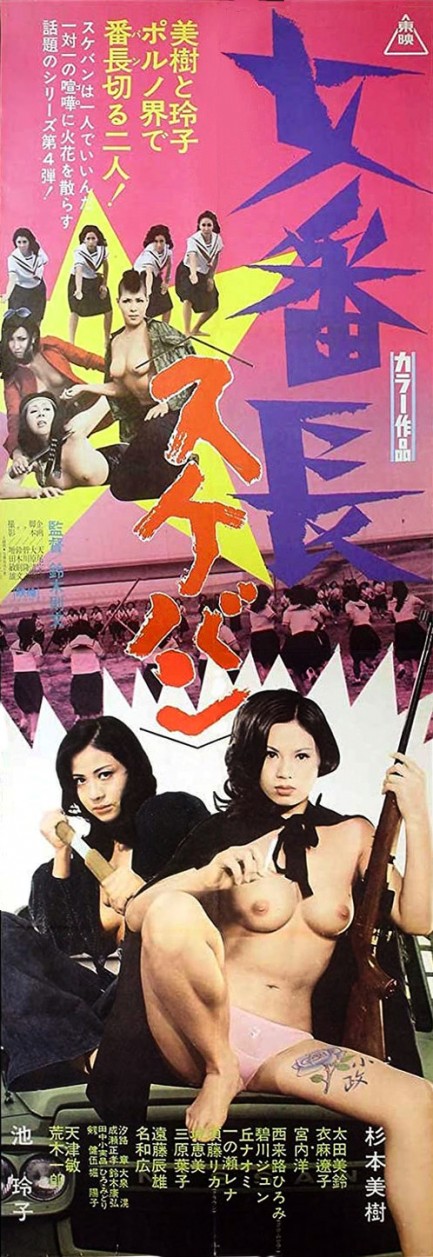
There’s quite a bit of information about Norifumi Suzuki’s pinky violence masterpiece Sukeban, aka Girl Boss Revenge: Sukeban on the web already, so we don’t need to add to it. And if you’re looking for posters, the promo art for this film is also abundant. But we can’t really call ourselves one of the go-to spots for pinku art without featuring this classic, so we have said poster above, with avenging angel Miki Sugimoto sporting a rose tattoo on her thigh, and co-star Reiko Ike lurking in the background. Keep an eye out on Pulp Intl.—we have an amazing nude promo poster of Sugimoto, never before seen on the internet, that we’ll be sharing in the next few weeks. Sukeban premiered in Japan today in 1973.
|
 |

The headlines that mattered yesteryear.
2003—Hope Dies
Film legend Bob Hope dies of pneumonia two months after celebrating his 100th birthday. 1945—Churchill Given the Sack
In spite of admiring Winston Churchill as a great wartime leader, Britons elect
Clement Attlee the nation's new prime minister in a sweeping victory for the Labour Party over the Conservatives. 1952—Evita Peron Dies
Eva Duarte de Peron, aka Evita, wife of the president of the Argentine Republic, dies from cancer at age 33. Evita had brought the working classes into a position of political power never witnessed before, but was hated by the nation's powerful military class. She is lain to rest in Milan, Italy in a secret grave under a nun's name, but is eventually returned to Argentina for reburial beside her husband in 1974. 1943—Mussolini Calls It Quits
Italian dictator Benito Mussolini steps down as head of the armed forces and the government. It soon becomes clear that Il Duce did not relinquish power voluntarily, but was forced to resign after former Fascist colleagues turned against him. He is later installed by Germany as leader of the Italian Social Republic in the north of the country, but is killed by partisans in 1945.
|

|
|

It's easy. We have an uploader that makes it a snap. Use it to submit your art, text, header, and subhead. Your post can be funny, serious, or anything in between, as long as it's vintage pulp. You'll get a byline and experience the fleeting pride of free authorship. We'll edit your post for typos, but the rest is up to you. Click here to give us your best shot.

|
|



 are mean as hell and the tortures they administer are hard to watch. But gangsters gonna gangster—if they spent their time at garden parties and poetry readings there'd be a different word for them.
are mean as hell and the tortures they administer are hard to watch. But gangsters gonna gangster—if they spent their time at garden parties and poetry readings there'd be a different word for them.









_m_(aka_violence_sweeper)_m_1974.jpg)










































































